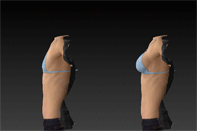More and more plastic surgeons are reporting that they’re seeing patients who come into their offices with unrealistic expectations. This is due in large part to social media and the instant ability it gives people to easily edit and manipulate their photos.
For example, the social media giant Snap Chat has sophisticated tools that enable people to apply filters to a picture of their face. They can give themselves plump lips, remove blemishes, and even change the way their eyes look.
These social media companies make the filters available for entertainment purposes, but many people are starting to use them as a model of what they want to look like.
They will come into the office of a plastic surgeon and instead of showing them what they want to be fixed in the mirror, they will show off several highly edited photos on their social media accounts.
The problem with people using their highly edited social media pictures is that the result they’re looking for is not possible in many cases. The social media companies made these filters for entertainment purposes only.
It’s impossible for people to have big cartoonish eyes or large puffy lips that go above and beyond what injectables can deliver.
We’re going to look at the trend of people wanting to get plastic surgery and non-surgical treatments to help them look more like the filters they see on their photos on social media.
What is Body Dysmorphic Disorder?
An article was published in the JAMA Plastic Surgery online website that claims more and more people are suffering from a condition known as body dysmorphic disorder (BDD). They say it’s fueled in significant part by the social media companies enabling filtering of photos that can create unrealistic pictures of people.
BDD is a mental condition in which a person is obsessed and focused on an imagined physical defect that other people cannot see. The filters on these social media sites allow people to take their pictures and edit them beyond what’s possible with plastic surgery and cosmetic injectables. BDD can lead to self-harming and other potentially dangerous situations for those who suffer from it.
What’s Behind the Rise of BDD?
We wrote an article about social media and the perception of plastic surgery a few months ago. In it, we explored how the social media sites are causing some people mental anguish and issues because they don’t look like their favorite celebrity.
The main reason for the increase in BDD cases is due to social media and people who have severe body image issues. When they are given filters and the instantaneous ability to change the look of their face or bodies, it can cause them to obsess and worry over their current looks.
They don’t quite understand that plastic surgery and injectables can only help out so much. It’s physically impossible to have plastic surgery to make your eyes or other body parts look like a cartoon character.
Unrealistic Expectations
Some surgeons from Johns Hopkins are reporting at least one person per week is coming up to them and asking to give them unrealistic results, such as:
- Flawless skin
- Refined nose
- Narrowed jawlines
- Oversized lips and eyes
These people are usually between the ages of 17 and 22 and are unable to distinguish fantasy from reality. The same study found that around 13% of prospective cosmetic surgery patients suffer from BDD.
A New Trend or Business as Usual?
While this may seem like an alarming new trend, it’s not new to most plastic surgeons. Before the advent of the internet and social media, people used to bring in heavily airbrushed photos of celebrities they see in the glamor magazines at the supermarket checkout stand.
The challenge then, as it is now, is that if you don’t share some physical similarities between you and the celebrity, it’s going to be impossible for a plastic surgeon to give you an exact look you want.
Social Media is Here to Stay
Social media is going to be around for a long time. The filters and abilities to edit photos can come in handy, provided that people have realistic expectations about what plastic surgery can and can’t fix. However, they shouldn’t be used as an indication of what’s physically possible with invasive or non-invasive surgical procedures. Only a qualified plastic surgeon can make that call.
As time goes by, it stands to reason that the filters on Snap Chat and other social media giants will get better and better and people will continue to stream into the offices of plastic surgeons with unrealistic expectations.
Plastic Surgeon in Dallas
If you are interested in learning more about what plastic surgery and injectables can and can’t do, or if you would like a consultation to see if the look you’re after is possible, give us a call at (214) 965-9885 or contact us via our website.








![BREAST AUGMENTATION [ MAMMOPLASTY, BOOB JOB ]](https://i0.wp.com/www.dr-adams.com/wp-content/uploads/2019/03/new-beauty-150x150.jpg?resize=150%2C150&ssl=1)








